|
Marshals of the Great Patriotic War
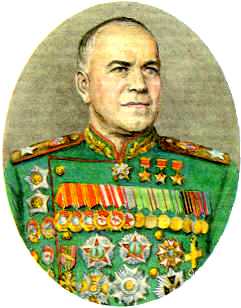 Georgy Zhukov Georgy Zhukov
19.11 (1.12).1896—18.06.1974
Great Military Leader,
Marshal of the Soviet Union,
USSR Minister of Defence
He was born in Strelkovka village not far from Kaluga in a rural family. He was in the Army since 1915. He took part in World War I. Was a junior non-commissioned officer in the cavalry. Was seriously wounded during the battles, and was rewarded with 2 Crosses of St.George (3rd and 4th classes).
Since August 1918 he was a member of the Red Army. During the Civil War Zhukov fought against the Ural Cossacks in the environs of Tsaritsyn, struggled with the armies of Denikin and Vrangel, took part in suppression of Tambov rebellion, was wounded, and rewarded with the Order of the Red Army. After the Civil War he was in command of regiment, subdivision, division, corps. In summer, 1939 led the successful operation on surrounding, and defeated the group of Japanese troops of general Kamatsubara on the river Khalkhin-Gol. G.K.Zhukov was awarded with the title oh the Hero of the Soviet Union and the Order of the Red Banner of the Mongolian Peoples’ Republic.
In the years of the Great Patriotic War (1941-1945) Zhukov was a member of Stavka, Deputy of Supreme Commander in Chief, he commanded the fronts (pseudonyms: Konstantinov, Yuriev, Zharov). He was the first who was awarded with the title of Marshal of the Soviet Union during the War (18.01.1943).
Under the command of Zhukov, troops of the Leningrad front in conjunction with the Baltic Fleet stopped the attack of Army Group “North” of Field Marshal F.V. von Leeb to Leningrad in September of 1941. Under his command, the Western front smashed the troops of Army Group “Centre” of Field Marshal F.von Bock in the environs of Moscow and shattered the myth about invincibility of the German fascist army. Then Zhukov coordinated actions of fronts nearby Stalingrad (operation “Uranus” - 1942), during the operation “Spark” in the breach of Leningrad Blockade (1943). He was a coordinator at the battle of Kursk (summer of 1943), where Hitler’s plan “Citadel” was deranged, and armies of Field Marshal Kluge and Field Marshal Manstein were smashed up.
With the name of Marshal Zhukov are also connected victories at Korsun-Shevchenko, the release of the Right-Bank Ukraine; Operation “Bagration” (in Belarus), where the “line of the Fatherland” was broken and the Army Group “Center”of Field Marshals von E. Bush and B. von Model was destroyed. At the final stage of the war the 1st Belorussian Front led by Marshal Zhukov took Warsaw (01.17.1945), cleaved the Army Group “A” of General von Garpe and Field Marshal F. Schorner in the Vistula-Oder offensive and victoriously finished the war by a grand Berlin operation. Together with soldiers marshal signed the scorched wall of the Reichstag, where the flag of victory was waving over the broken dome. On May 8, 1945 in Karlskhorst (Berlin) Zhukov received from the commander of Hitler's Field Marshal W. von Keitel unconditional surrender of Nazi Germany. General D. Eisenhower gave Zhukov the highest military order of the U.S. “Legion of Merit”, the degree of Commander (5.06.1945). Later, in Berlin at the Brandenburg Gate British Field Marshal Montgomery awarded him with the big Cross Military Order of the Bath 1st Class with a star and a crimson ribbon.
On June 24, 1945 Marshal Zhukov took a triumphant victory parade in Moscow.
In 1955-1957 “Marshal of the Victory” was the USSR Minister of Defence.
American military historian Martin Cayden says: “Zhukov was the commander of commanders in the war of mass armies of the twentieth century. He paid the Germans more losses than any other warlord. He was a “miracle-Marshal”. A military genius is before us”.
He wrote his memoirs “Memories and Reflections”.
Marshal Georgy Zhukov had:
-
4 Gold Stars of the Hero of the Soviet Union (29.08.1939, 29.07.1944, 1.06.1945, 1.12.1956),
-
6 Orders of Lenin,
-
2 Orders “Victory” (including № 1 – 11.04.1944, 30.03.1945),
-
Order of the October Revolution,
-
3 Orders of the Red Banner,
-
2 Orders of Suvorov of the 1st Class (including № 1), in all 14 Orders and 16 Medals;
-
Honorable weapon – inscribed sword with the gold Emblem of the USSR (1968);
-
Order of the Hero of the Mongolian People’s Republic (1969);
-
Order of the Tuvan People’s Republic;
-
17 foreign Orders and 10 Medals, etc.
A bronze bust and monuments were placed to great Zhukov. He is buried on Red Square near the Kremlin wall.
In 1995 a monument to Zhukov was placed at the Manege Square in Moscow.
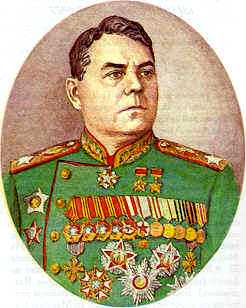 Alexander Vasilevsky Alexander Vasilevsky
18(30).09.1895—5.12.1977
Marshal of the Soviet Union,
The USSR Minister of Armed Forces
Vasilevsky was born in New (Novaya) Golchikha in the Kineshma Uyezd on the Volga. His father was a priest. Vasilevsky studied at Kostroma Seminary. In 1915 he finished the courses at the Alexander Military Law Academy and was sent to the front of World War I (1914 — 1918) with the rank of praporshchik (the highest non-commissioned rank in the Russian infantry). Than he became a staff-captain (officer or intermediate rank between lieutenant and captain) of the Tsarist Army. Having entered the Red Army during the Civil War (1918 — 1920) he became a commander of a company, a battalion, a regiment. In 1937 he graduated form the Military Academy of the General Staff. Since 1940 he was serving on the General Staff, where he entered the Great Patriotic War (1941 — 1945). In June, 1942 he was appointed Chief of the General Staff, replacing Marshal B.M. Shaposhnikov due to his illness. 22 months out of 34 months of tenure as Chief of the General Staff, A.M. Vasilevsky held directly at the front (pseudonyms: Mikhaylov, Alexandrov, Vladimirov). He was wounded and contused. Over a year and a half he rose from Major General to Marshal of the Soviet Union (19.02.1943), and along with K. Zhukov became the first Knight of the “Victory” Order. The largest operations of the Soviet Armed Forces were developed under his direct leadership. A.M. Vasilevsky coordinated the fronts: in the battle of Stalingrad (operations “Uranus”, “Little Saturn”), in the environs of Kursk (operation “Commander Rumyantsev”), when liberating Donets Basin (operation “Don”), in the Crimea and in the capture of Sevastopol, in the battles in the right-bank Ukraine; in Belarus (operation “Bagration”).
After the death of General I.D. Chernyakhovsky he commanded the 3rd Belorussian Front in the East-Prussian Operation, when Konigsberg was taken by the famous “star” storm.
On the fronts of the Great Patriotic War the Soviet leader Vasilevsky was smashing up such Hitler’s Field Marshals and Generals as F.von Bock, G. Guderian, F. Paulus, E. Manstein, E. Kleist, Eneke, E.von Bush, V.von Model, F. Schorner, M.von Weichs, etc.
On April, 19, 1945 he was rewarded with the 2nd Order “Victory”.
In June, 1945 Marshal received the appointment of Commander-in-Chief in the Far East (pseudonym: Vasilyev). For the quick defeat of the Japanese Kwantung Army of General O. Yamada in Manchuria commander received the second Gold Star. After the War: since 1946 – Chief of the General Staff; 1949 – 1953 – the USSR Minister of Armed Forces.
A.M. Vasilevsky is the author of the memoirs “The Matter of My Whole Life”.
Marshal Vasilevsky had
-
2 Gold Stars of the Hero of the Soviet Union (29.07.1944, 8.09.1945),
-
8 Orders of Lenin,
-
2 Orders “Victory” (including № 2 – 10.01.1944, 19.04.1945),
-
Order of the October Revolution,
-
2 Orders of the Red Banner,
-
The 1st Class Order of Suvorov,
-
Order of the Red Star,
-
The 3rd Class Order “For Service to the Homeland in the Armed Forces”,
-
In all 16 Orders and 14 Medals;
-
Honorable inscribed weapon - sword with the gold Emblem of the USSR (1968),
-
28 foreign awards (including 18 foreign Orders).
The urn with Vasilevsky ashes is buried on Red Square in Moscow near the Kremlin Wall next to the ashes of G.K. Zhukov. Bronze bust of the Marshal is installed in Kineshma.
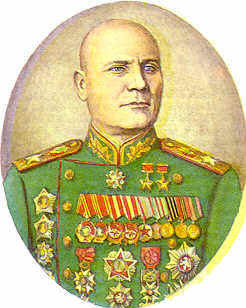 Ivan Konev Ivan Konev
16(28).12.1897—27.06.1973
Marshal of the Soviet Union
Ivan Konev was born in a peasant family in Lodeyno-village of the Vologda-region. In 1916 he was conscripted into the Army. After completing the training course of the Artillery Division as a junior non-commissioned officer, he was sent to the South-West front. After joining the Red Army in 1918, he was fighting against armies of Admiral Kolchak, Ataman Semyonov and the Japanese. He was the Commissar of the armoured train “Grozny”, then of a subdivision and division. In 1921 he took part in the storm of Kronstadt. Konev graduated from Frunze Military Academy (1934), was a commander of a regiment, division, corps, the 2nd Separate Far East Army of the Red Banner (1938-1940).
During the Great Patriotic War Konev commanded the army and fronts (pseudonyms: Stepin, Kievsky). He participated in the battles of Smolensk and Kalinin (1941), in the battle of Moscow (1941-1942). During the battle of Kursk, together with the forces of General N.F. Vatutin he defeated the enemy at the Belgorod-Kharkov bridgehead – the German bastion in the Ukraine. On August, 5, 1943, Konev’s troops liberated Belgorod. In honor of that Moscow has made its first salute. And Kharkov was captured on August, 5. Then the East Rampart on the Dnepr River was broken through.
In 1944 Konev’s army made a “New (Minor) Stalingrad” to the Germans. 1 brigade and 10 divisions of General V. Stemmeran were surrounded and destroyed. The General was killed in action. Konev was promoted to Marshal of the Soviet Union (20.02.1944). On March, 26, 1944 the armies of the 1st Ukrainian front were the first who achieved the state boarder. In July and August they defeated the Army Group “Northern Ukraine” of Marshal E.von Manstein in the Lvov-Sandomierz operation. Such brilliant victories as in the Vistula-Order, Berlin and Prague operations at the final stage of the war are linked with the name of Marshal Konev, nicknamed “the general forward”. During the Berlin operation Konev’s troops came up to the Elbe River at Torgau and met there the American’s troops of General O. Bradley (25.04.1945). On May, 9 Field Marshal Schorner was completely defeated near Prague. In honor of liberating Czech capital Marshal was awarded with Higher Orders — the 1st Class Order of “White Lion” and “Czechoslovakian Military Cross of 1939”. Moscow saluted 57 times to Konev’s troops.
In the postwar period the Marshal became a Commander of Soviet Ground Forces (1946 - 1956), the First Commander and then he was named Commander-in-Chief of the Armed Forces of the Warsaw Pact (1956 - 1960).
Marshal Ivan Konev is twice the Hero of the Soviet Union, the Hero of the Czechoslovakian Socialistic Republic (1970), the Hero of the Mongolian People’s Republic (1971). Bronze bust of Konev was settled in his Homeland — Lodeyno-village.
He wrote memoirs: “Year of Victory” and “Notes of the front commander”.
Marshal Konev had:
-
2 Gold Stars of the Hero of the Soviet Union (29.07.1944, 1.06.1945),
-
7 Orders of Lenin,
-
Order “Victory” (30.03.1945),
-
Order of the October Revolution,
-
3 Orders of the Red Banner,
-
2 Orders of Suvorov of the 1st Class,
-
2 Order of Kutuzov of the 1st Class,
-
Order of the Red Star,
-
In all 17 Orders and 10 Medals;
-
Honorable inscribed weapon–sword with the gold Emblem of the USSR (1968),
-
24 foreign awards (including 13 foreign Orders).
Konev was buried near the Kremlin Wall on Red Square in Moscow.
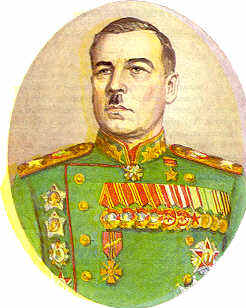 Leonid Govorov Leonid Govorov
10(22).02.1897—19.03.1955
Marshal of the Soviet Union
He was born in the village of Butyrki near Vyatka in the family of a peasant, who then became an employee in the city of Yelabuga. Being a student of Petrograd Polytechnical Institute, L.Govorov became a junker of Konstantinov Artillery School in 1916. He began his military career as an officer the White Army of Admiral Kolchak in 1916.
In 1919 he volunteered for the Red Army, participated in battles on the eastern and southern fronts, commanded artillery division, was wounded twice - under Kakhovka and Perekop.
He graduated from the Frunze Military Academy in 1933, and then from the Academy of the General Staff (1938). Took part in the Soviet-Finnish War (1939 – 1940).
During the Great Patriotic War (1941 – 1945) artillery General L.A. Govorov became a Commander of the 5th army defending avenues of approach to Moscow in the central direction. In spring of 1942 on the instructions of Joseph Stalin, he left for the besieged Leningrad, where he headed the Front (pseudonyms: Leonidov, Leonov, Gavrilov). On 18.01.1943 troops of Generals Govorov and Meretskov broke through the blockade of Leningrad (Operation “Spark” (“Iskra”)), having caused a counter-punch near Schlusselburg. A year later, they struck a new blow, having crushed the “Northern Wave” of the Germans, completely lifting the blockade of Leningrad. German forces of Field Marshal von Kyukhler had suffered huge losses. In June, 1944 troops of the Leningrad Front had the Vyborg operation, broke through the “Mannerheim Line” and took the city of Vyborg. Govorov became Marshal of the Soviet Union (18.6.1944). In autumn of 1944 armies of Govorov liberated Estonia, having cracked the enemy defense “Panther”.
Being the commander of the Leningrad Front, the marshal at the same time was a representative of “Stavka” in the Baltics. He was named a Hero of the Soviet Union. In May 1945, the German Army Group “Kurland” surrendered to the front’s troops.
Moscow saluted 14 times to the troops of the commander.
In the postwar period the Marshal was appointed the first Commander of National Air Defence Forces.
Marshal L.A. Govorov had:
-
The Gold Star of the Hero of the Soviet Union (27.01.1945),
-
5 Orders of Lenin,
-
Order “Victory” (31.05.1945),
-
3 Orders of the Red Banner,
-
2 Orders of Suvorov of the 1st Class,
-
The 1st Class Order of Kutuzov,
-
Order of the Red Star – in all 13 Orders and 7 Medals,
-
Order of the Tuvan People’s Republic,
-
3 foreign Orders.
Died in 1955 at 59. Buried in the Red Square, Moscow, near the Kremlin Wall.
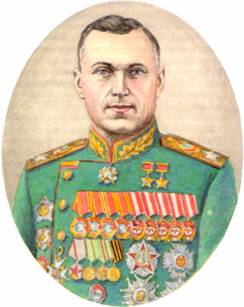 Konstantin Rokossovsky Konstantin Rokossovsky
9(21).12.1896—3.08.1968
Marshal of the Soviet Union,
Marshal of Poland
He was born in Velikie Luki in the family of a railroad engineer, a Pole Xavier Joseph Rokossovsky, who soon moved to Warsaw. He began serving in the Russian army in 1914. He participated in the First World War. He fought in the cavalry regiment, was a non-commissioned officer, was twice wounded in fights, and was awarded the George Cross and two medals. He was also a Red Guard (1917). During the Civil War was twice wounded, he fought on the Eastern front against the forces of Admiral Kolchak and against Baron Ungern in Transbaikalia; he commanded a squadron, battalion, cavalry regiment; was awarded two Orders of the Red Banner. In 1929 he fought against the Chinese in Dzhalaynor (conflict of the CER). In 1937-1940 he was in detention, being a victim of slander.
During the Great Patriotic War (1941-1945) he commanded a mechanized corps, army, front (pseudonyms: Costin, Dontsov, Rumyantsev). He distinguished himself in the battle of Smolensk (1941). He became the Hero of the Battle of Moscow (30.09.1941-8.01.1942). He was seriously wounded at Sukhinichi. During the Battle of Stalingrad (1942-1943) the Don Front of Rokossovsky with other fronts surrounded 22 enemy divisions totaling 330 thousand people (Operation “Uranus”). In early 1943, the Don Front liquidated surrounded group of Germans (Operation “Ring”). Marshal F. Paulus was taken in the prisoner (Germany declared a 3-day mourning period). In the Battle of Kursk (1943) the Central Front of Rokossovsky defeated the German army of General Model (Operation “Kutuzov”) in the environs of Orel, in honor of what Moscow has made its first fireworks (5.08.1943). In the grand Belorussian operation (1944) the 1st Belorussian Front of Rokossovsky defeated the Army Group “Center” of Field Marshal von Bush, and together with the troops of General I.D. Chernyakhovsky surrounded in “Minsk pot” up to 30 divisions of dredge (Operation “Bagration”). On June 29, 1944 Rokossovsky was awarded the title of Marshal of the Soviet Union. The highest military order “Virtuti Military” and the 1st Class Cross “Grunwald” became a reward to the Marshal for the liberation of Poland.
At the final stage of the War the 2nd Belorussian Front of Rokossovsky participated in the East Prussian, Pomeranian and Berlin operations. Moscow saluted 63 times to the troops of Commander Rokossovsky. On June 24, 1945 he twice became a Hero of the Soviet Union, a knight of the Order “Victory”; Marshal K.K. Rokossovsky commanded the Victory Day parade on Red Square in Moscow. In 1949-1956 K.K. Rokossovsky was the Minister of National Defence of the Polish People's Republic. He was awarded the title of Marshal of Poland (1949). Having returned to the Soviet Union, he became Chief Inspector of the USSR Ministry of Defence.
He wrote the memoirs “Soldier’s Duty”.
Marshal K.K. Rokossovsky had:
-
2 Gold Stars of the Hero of the Soviet Union (29.07.1944, 1.06.1945),
-
7 Orders of Lenin,
-
The Order “Victory” (30.03.1945),
-
The Order of the October Revolution,
-
6 Orders of the Red Banner,
-
The 1st Class Order of Suvorov,
-
The 1st Class Order of Suvorov,
-
In all 17 Orders and 11 Medals;
-
Honoured weapon — sward with the Gold Emblem of the USSR (1968),
-
13 foreign rewards (including 9 foreign Orders)
He was buried on Red Square near the Kremlin Wall in Moscow. Rokossovsky’s bronze bust is installed in his Homeland (Velikie Luki).
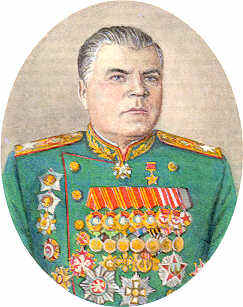 Rodion Malinovsky Rodion Malinovsky
11(23).11.1898—31.03.1967
Marshal of the Soviet Union,
the USSR Minister of Defense
Malinovsky was born in Odessa, he was being brought up without a father. In 1914 he volunteered for the front of the 1st World War, where he was wounded and awarded the 4th Class George Cross (1915). In February of 1916 he was sent to France in the Russian expeditionary corps. He was again wounded there and received the French War Cross. After returning home, he voluntarily joined the Red Army (1919), fought against the whites in Siberia. In 1930 he graduated from the Frunze Military Academy. In 1937-1938 as a volunteer he involved in the fighting in Spain (under the pseudonym “Malino”) on the side of the Republican government, and was awarded the Order of the Red Banner.
During the Great Patriotic War he commanded the corps, the army and the front (pseudonyms: Yakovlev, Rodionov, Morozov). He distinguished himself in the Battle of Stalingrad. The Army of Malinovsky, in cooperation with other armies halted, and then defeated the Army Group “Don” of. Field Marshal E von Manstein, who tried to relieve encircled at Stalingrad grouping of Paulus. General Malinovsky’s troops liberated Rostov and Donbass (1943), participated in clearing the enemy from the Right-Bank Ukraine; defeated the army of E. von Kleist and took Odessa on 10.04.1944; together with the forces of General Tolbukhin defeated the southern wing of the enemy’s front encircling 22 German divisions and the 3rd Romanian Army in the Iasi-Kishinev operation (20-29.08.1944). During the fighting, Malinovsky was slightly wounded; he was awarded the title of Marshal of the Soviet Union (10.09.1944). Troops of the 2nd Ukrainian Front of Marshal Malinovsky liberated Romania, Hungary, Austria and Czechoslovakia. On August 13, 1944 they entered Bucharest, took it by storm (13.02.1945), then they liberated Prague (09.05.1945). Marshal was awarded the Order “Victory”.
From July 1945 Malinovsky commanded the Trans-Baikal Front (pseudonym — Zakharov), which causes the brunt to the Japanese Kwantung Army in Manchuria (08.1945). The troops reached the front of Port Arthur. Marshal was awarded the title of a Hero of the Soviet Union.
Moscow saluted 49 times to the troops of Commander Malinovsky. In this position he remained until his death.
The Marshal wrote: “Soldiers of Russia”, “Wrathful vortices of Spain”; under his leadership were written “Iasi-Chisinau "Cannes”, “Budapest — Vienna — Prague”, “Finale” and other works.
The Marshal wrote: “Soldiers of Russia”, “Wrathful vortices of Spain”; under his leadership were written “Iasi-Chisinau "Cannes”, “Budapest — Vienna — Prague”, “Finale” and other works.
Marshal R.Ya. Malinovsky had:
-
2 Gold Stars of the Hero of the Soviet Union (8.09.1945, 22.11.1958),
-
5 Orders of Lenin,
-
The Order “Victory” (26.04.1945),
-
3 Orders of the Red Banner,
-
2 Orders of Suvorov (1st Class),
-
The 1st Class Order of Kutuzov,
-
In all 12 Orders and 9 Medals;
-
24 foreign awards (including 15 foreign Orders). In 1964 he was awarded the title of the People’s Hero of Yugoslavia.
Bronze bust of the Marshal is installed in Odessa. Malinovsky was born on Red Square near the Kremlin Wall.
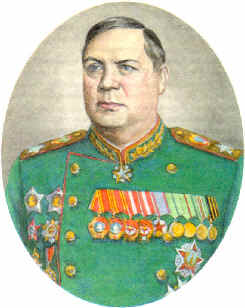 Fedor Tolbukhin Fedor Tolbukhin
4(16).6.1894—17.10.1949
Marshal of the Soviet Union
Fedor Tolbukhin was born in a peasant family in Androniki-village near Yaroslavl. He was an accountant in Petrograd. In 1914 he was a private-motorcyclist. After becoming an officer, he participated in the battles with Austro-German troops, was awarded the Orders of Anna and Stanislaw.
Tolbukhin joined the Red Army in 1918; fought in the Civil War against forces of General Yudenich, the Poles and the Finns. He was awarded the Order of the Red Banner.
After the Russian Civil War ended, Tolbukhin was given a number of staff positions. In 1934 he graduated from the Frunze Military Academy. In 1940 he became a General.
During the Great Patriotic War (1941-1945.) he was Chief of Staff of the front, commanded an army and front. Distinguished himself in the Battle of Stalingrad, when commanding the 57th Army. In the spring of 1943 Tolbukhin became a commander of the Southern Front, from October – the 4th Ukrainian Front, and from May 1944 until the end of the war - the 3rd Ukrainian Front. The troops of General Tolbukhin defeated enemy on the Miuss and the Molochnaya rivers, liberated Taganrog and the Donbass. In the spring of 1944 invaded the Crimea and on May, 9 stormed Sebastopol. In August 1944 together with the troops of R.Ya. Malinovsky defeated the army group “South Ukraine” of General Mr. Friessner in the Iasi-Kishinev operation. On September, 12, 1944 F.I. Tolbukhin was awarded the title of Marshal of the Soviet Union.
Tolbukhin’s troops liberated Rumania, Bulgaria, Yugoslavia, Hungary and Austria. Moscow saluted 34 times for the troops of Tolbukhin. On the Parade of Victory on June, 24, 1945 the Marshal led a column of the 3rd Ukrainian Front.
War-torn health of Marshal began to pass, and in 1949 F.I. Tolbukhin died on the 56th year of life. It was declared a three-day mourning period in Bulgaria, the city of Dobrich was renamed Tolbukhin.
In 1965 Marshal F. Tolbukhin was posthumously awarded the Hero of the Soviet Union.
The People’s Hero of Yugoslavia (1944) and “The Hero of the People’s Republic of Bulgaria” (1979), Marshal F. Tolbukhin had:
-
2 Orders of Lenin,
-
The Order “Victory” (26.04.1945),
-
3 Orders of the Red Banner,
-
2 Orders of Suvorov (the 1st Class),
-
The Order of Kutuzov (the 1st Class),
-
The Order of the Red Star,
-
In all 10 Orders and 9 Medals;
-
10 foreign awards (including 5 foreign Orders).
The urn containing his ashes is buried on Red Square near the Kremlin wall in Moscow.
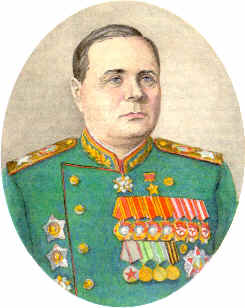 Kirill Meretskov Kirill Meretskov
26.05(7.06).1897—30.12.1968
Marshal of the Soviet Union
Meretskov was born in Nazarievo-village near Zaraysk, Moscow region into a peasant family. He worked as a metalworker prior the military service. He joined the Red Army in 1918. During the Civil War he was fighting on the Eastern and Southern Fronts. He participated in the fighting in the ranks of the 1st Cavalry against the Poles of Pilsudsky. Meretskov was awarded the Order of the Red Banner.
In 1921 he graduated form the Military Academy of the Workers-Greeners Red Army. During 1936 – 1937 was fighting in Spain under the pseudonym “Petrovich” (was awarded the Order of Lenin and the Order of the Red Banner). During the Soviet-Finnish War (December 1939 – March 1940) he commanded the army which broke through the “Line of Manergeym” and captured Viborg for what he was awarded the rank of the Hero of the Soviet Union (1940).
During the Great Patriotic War he commanded the troops of the northern areas (pseudonyms:: Afanasyev, Kirillov); was the representative of the Stavka on the North-Western Front. He commanded an army and a front. In 1941 Meretskov paid the first serious defeat in the war to the troops of Field Marshal Leeb in the environs of Tikhvin. On January, 18, 1943 troops of Generals Govorov and Meretskov, having dealt a blow near Schlisselburg (Operation “Spark”), broke through the blockade of Leningrad. Novgorod was taken on January, 20. In February 1944 he became a commander of the Karelian Front. In June 1944 Meretskov and Govorov defeated Marshal K. Mannerheim in Karelia. In October 1944 the troops of Meretskov defeated the enemy in the Arctic near Pechenga (Petsamo). On October, 26, 1944, K. Meretskov received the title of Marshal of the Soviet Union and the Norwegian King Haakon VII awarded to him the Grand Cross of “St. Olav”.
In spring of 1945 “a cunning Yaroslavets” (as Stalin called him) under the name of “General Maksimov”, Meretskov was sent to the Far East. In August – September of 1945 his troops took part in the defeat of the Kwantung Army, breaking from Primorye into Manchuria and releasing areas of China and Korea.
Moscow saluted to the troops of commander Meretskov 10 times.
Marshal K.A. Meretskov had:
-
The Gold Star of the Hero of the Soviet Union (21.03.1940),
-
7 Orders of Lenin,
-
The Order “Victory” (8.09.1945),
-
The Order of the October Revolution,
-
4 Orders of the Red Banner,
-
2 Orders of Suvorov (the 1st Class),
-
The Order of Kutuzov (the 1st Class),
-
10 Medals;
-
Honorable weapon – inscribed sword with the gold Emblem of the USSR,
-
4 superior foreign Orders and 3 Medals.
Meretskov wrote memoirs “Serving people”. He was buried on Red Square near the Kremlin Wall in Moscow.
|
